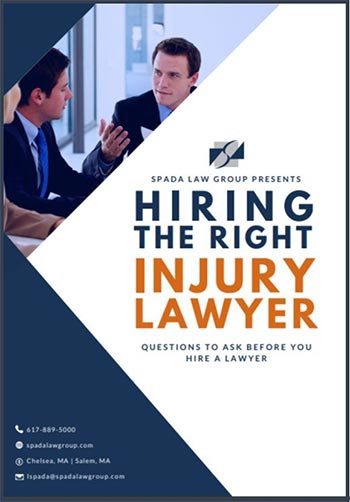Does Massachusetts Law Require Drivers To Remove Ice and Snow From Vehicles?![Snow Ice Car Accident Boston Lawyer]()
It's a cold New England morning. You are driving down Route 128 on your way to work. It had been a very snowy 24 hours and it took you considerable effort to clear off your car and get moving this morning. As you are driving a large slab of ice and snow blows off the roof of a large tractor trailer in front of you and the ice flies right at your car. You swerve and in doing so you collide with a car in another lane. Thankfully no one is hurt. The tractor trailer continues on its way, the driver unaware he just caused an accident. This scenario plays out many times each winter here in Massachusetts. Sometimes with tragic results. This blog will answer the following questions that arise when something like this happens: (1) How to avoid this situation; (2) What the consequences could be if you are the one who fails to clean your vehicle properly; (3) What rights you might have if you are injured in an accident caused by falling snow and ice from another vehicle.
How to Avoid Car Accidents Caused by Blowing Snow and Ice
This is an easy one. First, take the time to properly clear your vehicle of all snow and ice before you hit the road. Some people only remove enough snow and ice to get enough visibility to get their car operational and then hope the rest will either melt or blow off during the drive. This is a dangerous mistake. You must take off all the snow and ice that could blow off while you are driving and cause a hazard to other drivers. That includes the windows, the hood, trunk and most importantly the roof. Then and only then should you start your drive. A good idea is to start your car 10 minutes before you begin snow removal, to give the ice and snow a chance to soften and make removal easier.
Once on the road, pay attention to vehicles in front of you, regardless of which lane they are in, and make note of any excess snow and ice on those vehicles which could blow off and cause you a problem. If you notice any, keep twice the distance behind them that you normally would or make an attempt to pass them if it is safe to do so. If you see a tractor trailer or any truck where you can’t see the roof of the vehicle, get out of its rear path. Do not travel directly behind the truck and again, pass it if safe to do so.
What Are the Consequences for Not Clearing Your Vehicle of Ice and Snow?
Massachusetts, unlike some states, does not have a specific law requiring the removal of snow and ice from vehicles. State Police however have been issuing citations using two laws currently on the books in Massachusetts.
The first law is M.G.L. c. 90 sec. 13 which provides “No person, when operating a motor vehicle, shall permit to be on … the vehicle … anything which may interfere with or impede the proper operation of the vehicle…” So, if the police officer deems that snow or ice on your vehicle somehow impedes or interferers with your visibility, guess what? Ticket time!
The other law is M.G.L. c. 85 sec. 36 which states “No person shall drive … unless such vehicle is … loaded so as to prevent any of its load from dropping, …or otherwise escaping therefrom…” If you are seen with ice flying off your car as you drive down the road, a police officer could determine you are in violation of this law and cite you.
If you cause an accident because your visibility was reduced due to uncleared snow on your car or falling ice from your car caused another vehicle to crash, you most likely will be found more than 50% at fault for the crash and face civil liability. This means anyone injured as a result of your negligence can sue you to collect money damages for their injuries. We have represented clients who have been injured when ice and snow from a vehicle in front of the has flown off onto their car causing a crash.
What Rights Do You Have If You Are Injured Due to Flying Ice and Snow?
Well if you are fortunate enough to get the license plate of the vehicle that caused the accident you obviously can pursue a claim against that driver and their insurance carrier, if they have insurance. Like I mentioned above, if you can prove that the other party failed to remove ice or snow from their vehicle and that was the cause of the collision you are likely to prevail.
The more common scenario occurs when the vehicle causing the accident simply keeps driving because they had no idea their flying wintry debris caused an accident. Then you have a more challenging problem. In this scenario, if you are injured, you can make a claim with your own car insurance company for damages under your policy’s “Uninsured Motorist” provisions. If you are able to convince your insurance company that an “unidentified” vehicle caused your accident you may be able to collect money damages even without being able to identify the at fault party.
It is our experience that insurance companies take a hard stance in hit and run cases. They are always suspicious that the injured person is at fault and may even be concocting a story about an “unidentified vehicle” to cover their own negligence. The best thing you can do if you find yourself in this unfortunate situation is to understand your legal rights before you make any decisions. Before you speak to an insurance company adjuster, sign or submit any paperwork or hire a lawyer, you owe it to yourself to get as much information as you can, so you can make a smart decision on what you need to do next. At Spada Law Group, we offer free consumer guides and videos that answer many of the questions car accident victims have. Take a look, download our free information or contact us for a free consultation. Learn what Spada Law Group is all about and how we might be the right personal injury lawyers for you and your case.




